
来源:科技世代千高原
许多持反对态度的人对宇宙膨胀的发生提出质疑。但证据表明事实并非如此。
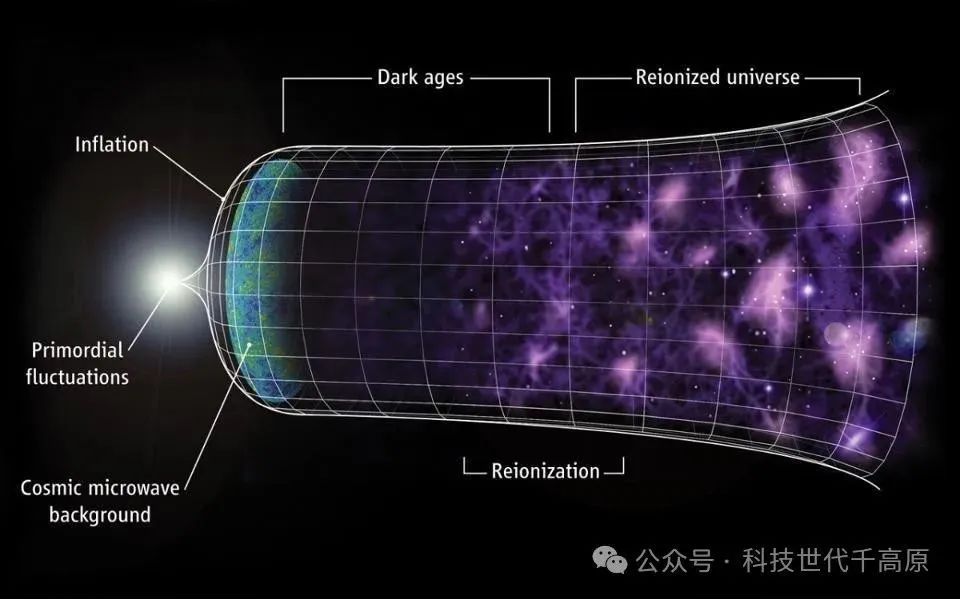
不断膨胀的宇宙充满了星系和我们今天观察到的复杂结构,它起源于一个更小、更热、更致密、更均匀的状态。尽管今天可观测宇宙的范围在各个方向上延伸了大约 460 亿光年,但在遥远的宇宙过去,太空中的一切都更加紧凑、更紧密,体积也更小,这引出了一个问题:是什么推动了宇宙的膨胀,无论是在最初热大爆炸之初,还是在今天宇宙晚期,膨胀正在加速? 图片来源:C.-A. Faucher-Giguere、A. Lidz 和 L. Hernquist,《科学》,2008 年
关键要点
研究大爆炸可以告诉我们宇宙是如何演化成现在这个样子的,但并不能立即揭示大爆炸发生的原因或之前可能发生的事情。
从理论和观察上看,大爆炸之前和之后的宇宙膨胀的证据非常有力且全面。
仍有一些新的、敏感的事物需要衡量,但缺乏低垂的果实并不意味着树已经死了。
作者:Ethan Siegel
http://If%20the%20Big%20Bang%20wasn't%20the%20first%20thing%20ever,%20what%20caused%20it?
自从人类出现以来,我们与生俱来的好奇心就迫使我们不断询问宇宙的问题。为什么事物会是现在这个样子?它们是如何变成这样的?这些结果是不可避免的吗?还是如果我们让时光倒流,一切重新开始,事情会不会有所不同?从亚原子相互作用到宇宙的宏大尺度,我们对这一切感到好奇是很自然的。无数代以来,哲学家、神学家和神话创造者一直试图回答这些问题。虽然他们的想法可能很有趣,但绝不是权威的。
现代科学为解决这些难题提供了一种更好的方法。我们不再认为大爆炸(曾被认为是宇宙的最终起源)发生在时空中的某个时刻或事件中。我们现在可以问这样的问题:“大爆炸之前存在什么?”以及“为什么会发生大爆炸?”当涉及到所有问题中最大的问题时,科学会根据我们已知的和未知的,在任何时间点为我们提供最好的答案。目前,这些是我们能够得出的最有力的结论。
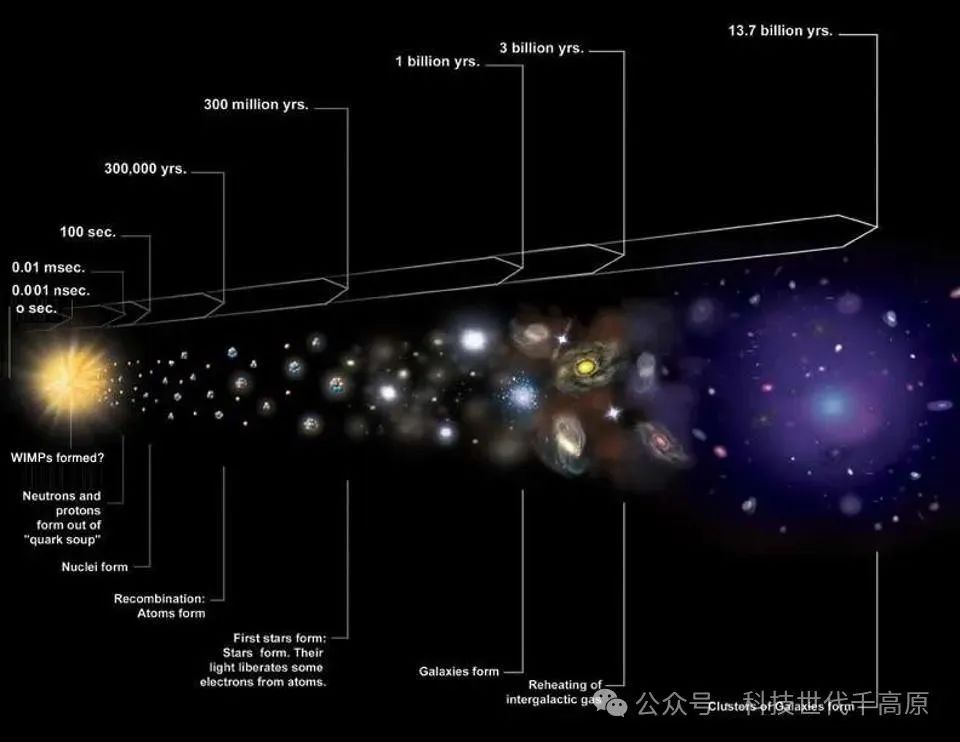
宇宙膨胀的视觉历史包括被称为大爆炸的高温致密状态以及随后的结构的生长和形成。包括对轻元素和宇宙微波背景的观测在内的全套数据,使得大爆炸成为我们所看到的一切的有效解释。随着宇宙的膨胀,它也会冷却,从而形成离子、中性原子,最终形成分子、气体云、恒星,最后形成星系。
来源:NASA/CXC/M. Weiss
当我们观察当今宇宙中的星系时,我们发现——平均而言——星系距离我们越远,其光线向更长、更红的波长偏移的程度就越大。光线在到达我们的眼睛之前在宇宙中传播的时间越长,宇宙膨胀对其波长的拉伸程度就越大;这就是我们发现宇宙正在膨胀的原因。由于拉伸后的长波长光比短波长光更冷,因此宇宙在膨胀时会冷却。如果我们沿时间向后推而不是向前推,我们会预期早期宇宙处于更热、更致密、更均匀的状态。
最初,我们尽可能地往前推——无限的温度和密度,以及无限小的体积:奇点。从初始状态向前发展,我们成功地预测并观察到:
大爆炸留下的辐射,可以观测到的宇宙微波背景
恒星形成前的轻元素丰度
宇宙大尺度结构的引力增长
然而,我们还观察到了一些如果宇宙起源于单一状态就无法解释的事情,包括为什么没有最高能量时代留下的遗迹,为什么宇宙在相反的方向上具有相同的属性,而这些属性永远不可能相互交换信息,以及为什么绝对没有空间曲率,使宇宙与平坦难以区分。
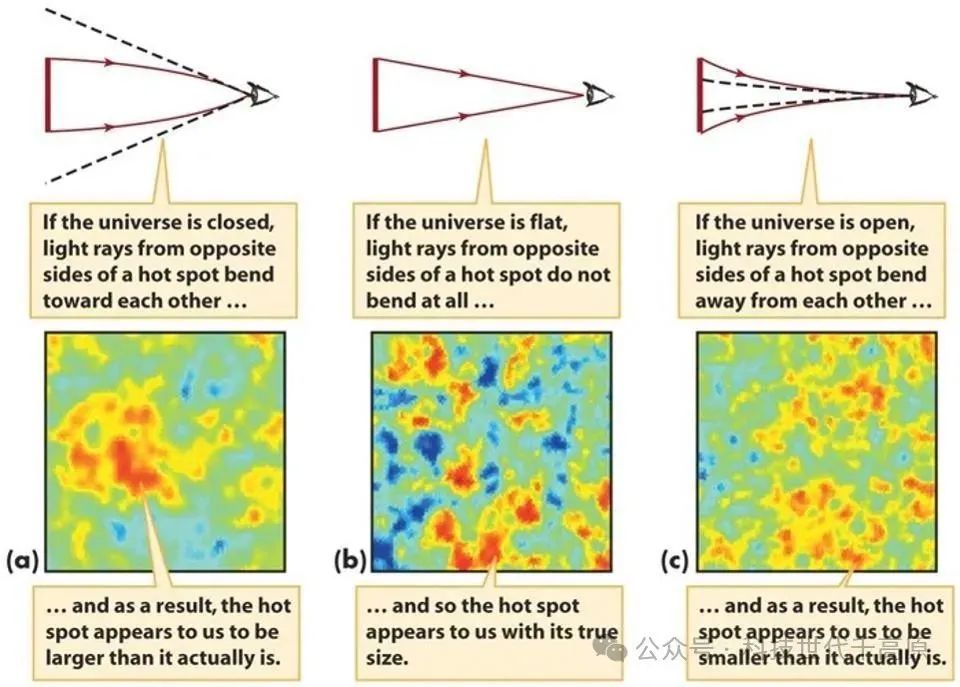
热点和冷点的大小及其尺度表明了宇宙的曲率。据我们所能测量,宇宙是完全平坦的。重子声学振荡和 CMB 一起提供了限制这一点的最佳方法,综合精度可达 0.4%。据我们所能测量的最好,宇宙与空间平坦没有区别。来源:斯穆特宇宙学小组/LBL
每当我们遇到这种情况时(观察到我们的主要理论无法解释或预测的属性),我们就只剩下两个选择:
你可以把这些属性当作“初始条件”。为什么宇宙是平的?它天生如此。为什么到处都是相同的温度?它天生如此。为什么没有高能遗迹?它们一定不存在。等等。这个选项没有提供任何解释。
你可以想象某种动态:一种先于我们观察到的状态并进行设置的机制,以便它从创建我们今天观察到的属性所必需的条件开始。
虽然这么说有点争议,但第一种选择只有在你确定开始时的条件足够随机时才是可以接受的。例如,太阳系是由新形成恒星周围的原行星盘的不稳定性形成的;这是随机的,所以无法解释为什么我们的太阳系拥有一组特定的行星。但对于整个宇宙来说,选择那个选项就等于放弃动力学,断言甚至不需要寻找一种可能先于并建立热大爆炸的机制。
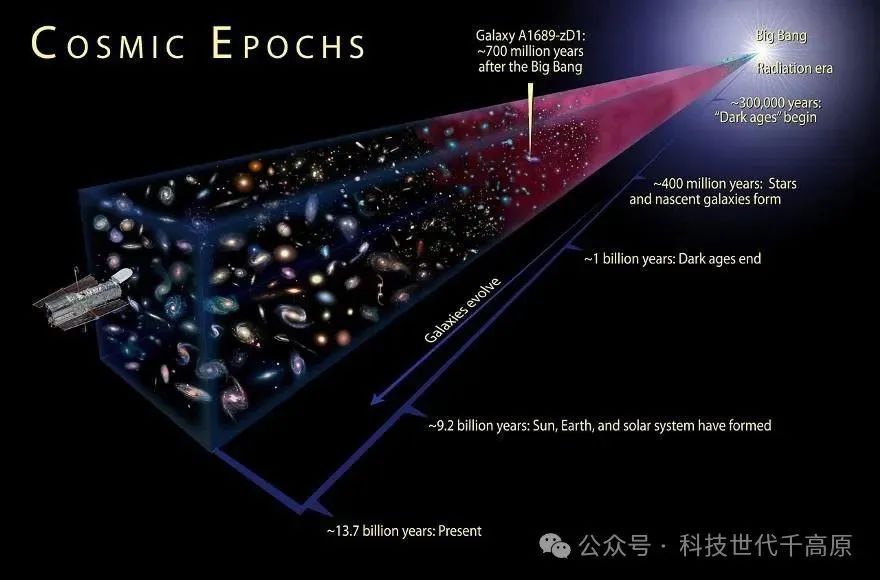
我们今天看到的恒星和星系并非一直存在,我们回溯得越远,宇宙就越接近奇点,因为我们会进入更热、更致密、更均匀的状态。然而,这种推断是有限度的,因为一路回溯到奇点会产生我们无法解答的谜题。来源:NASA、ESA 和 A. Feild (STScI)
然而幸运的是,并不是每个人都陷入了这种唯我论的逻辑谬误。如果你想超越你目前对事物运作方式的理解,只需要一个新的、更优越的想法。你如何知道一个想法是否足以取代我们的旧理论并彻底改变我们对宇宙的看法?信不信由你,你只需要满足三个标准:
它必须重现旧理论所取得的每一个成功。每一个,无一例外。
它必须成功解释旧理论无法解释的现象,从而达到旧理论无法实现的目标。
也许最重要的是,它需要做出与旧理论预测不同的新预测。然后必须对这些新预测进行测试,以确定新想法的成败。
这正是 40 多年前宇宙膨胀(有时称为宇宙膨胀)概念的目的。该概念假设,在宇宙充满物质和辐射之前,宇宙由空间结构本身固有的能量主导。这种能量导致宇宙呈指数级无情地膨胀。膨胀会拉伸空间,使其看似平坦,导致所有方向的温度相同,因为一切都在过去存在因果联系。最终,这个过程将对早期宇宙达到的最高温度设置上限,从而阻止高能遗迹的形成。
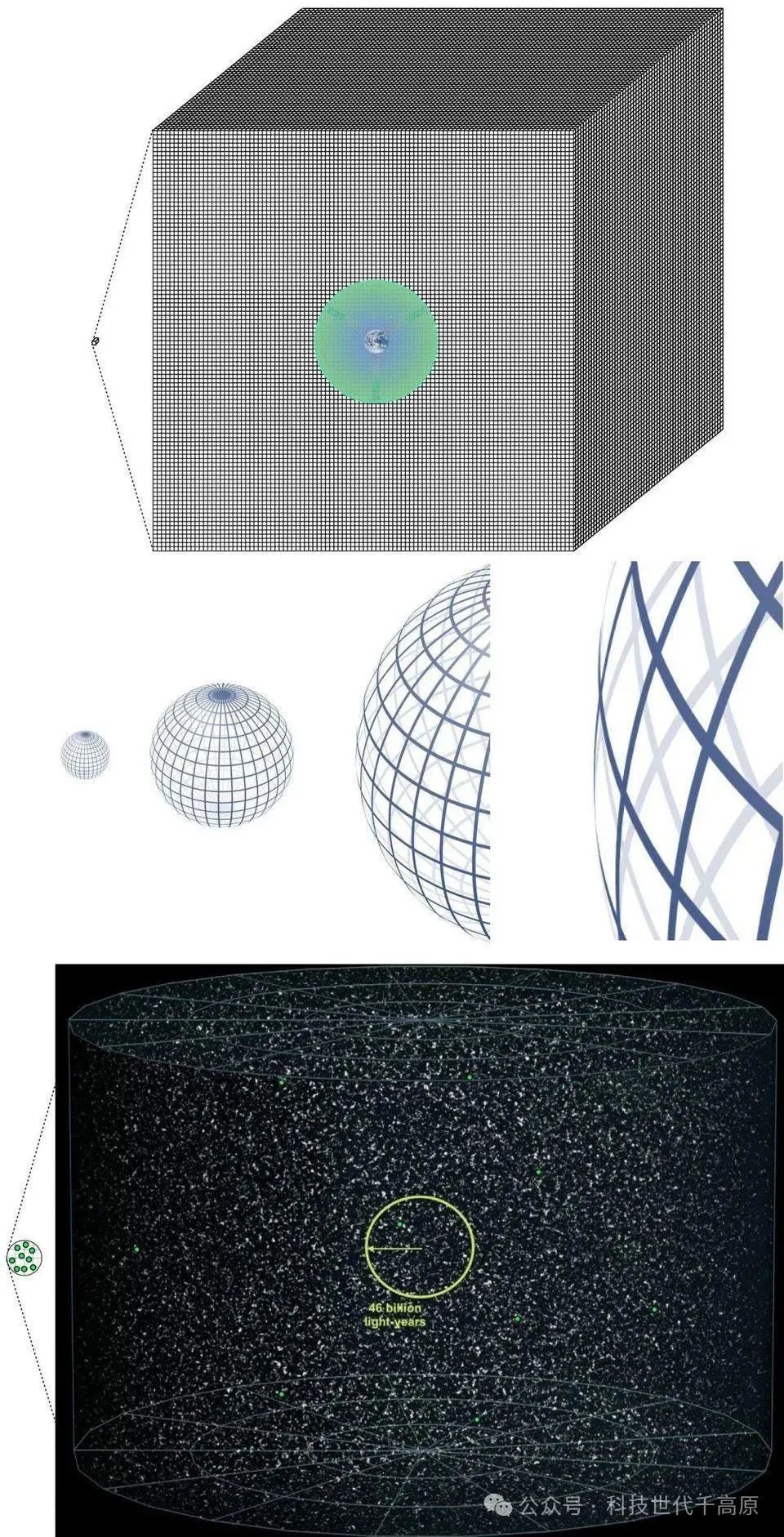
在上图中,我们现代宇宙的各处都具有相同的属性(包括温度),因为它们起源于具有相同属性的区域。在中间图中,原本可以具有任意曲率的空间膨胀到我们今天无法观察到任何曲率的程度,从而解决了平坦度问题。而在下图中,先前存在的高能遗迹被膨胀消失,为高能遗迹问题提供了解决方案。这就是膨胀如何解决大爆炸本身无法解释的三大难题。
来源:E. Siegel/Beyond the Galaxy
最初的宇宙膨胀模型成功了,而没有膨胀的大爆炸模型却失败了,但它很难满足第一个标准,因为它未能产生一个在各个方向上都具有统一属性的宇宙。然而,随着社区的努力,人们迅速发现了能够重现大爆炸成功的类模型,并由此开启了一个丰富的理论探索时代。我们将宇宙膨胀建模为一个领域,然后物理定律将使我们能够从我们选择的任何特定模型中提取宇宙中印记的属性。这些细节主要是在 20 世纪 80 年代和 90 年代制定的,并可在该领域的各种教科书中找到,包括:
科尔布和特纳的 《早期宇宙》
约翰·皮科克的 宇宙物理学,
Liddle 和 Lyth 的 宇宙膨胀和大尺度结构,
以及斯科特·多德尔森的 现代宇宙学。
多德尔森的书成为了该领域的标准,它解释了宇宙膨胀对宇宙的影响,特别是在宇宙微波背景中。如果你在过去 30 年内读过研究生宇宙学,那么这些是许多开创性的主要资料,它们教会你如何从膨胀中提取一些关键预测,这些预测与没有发生膨胀的宇宙不同。

早期宇宙膨胀时期的大、中、小尺度波动决定了大爆炸余辉中的热点和冷点(密度低和密度高)。这些波动在膨胀过程中会延伸到整个宇宙,小尺度和大尺度的波动幅度应该略有不同:这一预测已通过观测证实,约为 3% 的水平。来源:NASA/WMAP 科学团队
具体来说,宇宙膨胀的六个主要预测在进行检验之前就已被明确地提出。宇宙膨胀预测:
一系列缺陷(密度和温度波动)几乎(但不是完全)具有尺度不变性
一个与平坦宇宙大致难以区分的宇宙,但其曲率约为 0.001%
本质上具有 100% 绝热和 0% 等曲率的密度缺陷
超视界尺度的波动,比在膨胀的宇宙中以光速移动的信号可能产生的波动更大
热大爆炸期间宇宙的最高温度有限,应该比普朗克尺度小得多
还应该创建一个具有特定模式的引力波波动谱——张量波动。
所有这六个预测早在 WMAP 或普朗克卫星传回第一批数据之前就已经存在,这使我们能够测试宇宙膨胀与非膨胀情景。从那时起,我们已经观察到支持第 1、3、4 和 5 点宇宙膨胀的强有力证据,但尚未达到揭示第 2 和第 6 点决定性信号的灵敏度。然而,在我们能够测试的 4 个点中,4 个点已经足以验证膨胀,使其成为我们宇宙起源的新共识解释。膨胀在热大爆炸之前就已出现并建立,而推断回到奇点现在已成为毫无根据的假设。
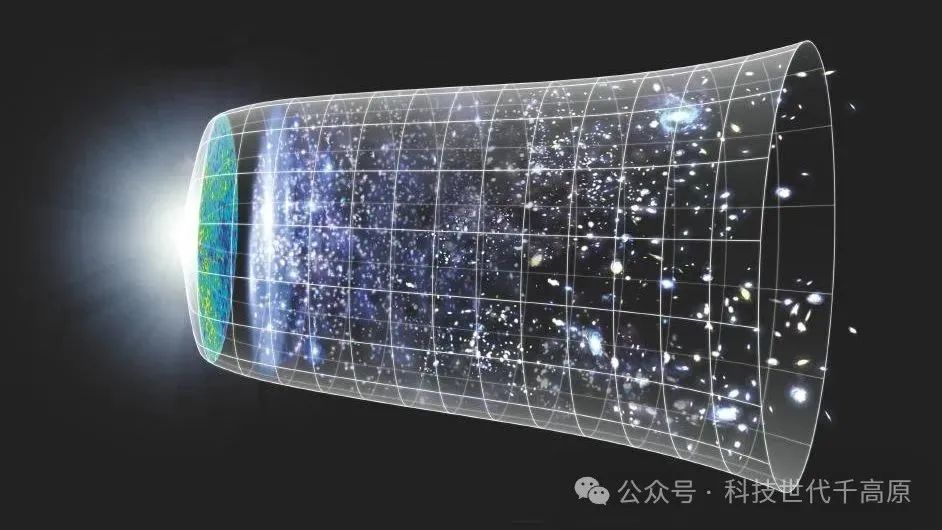
现代宇宙图景描绘的宇宙历史并非始于我们认定的大爆炸奇点,而是始于宇宙膨胀时期,宇宙膨胀将宇宙拉伸至巨大尺度,具有均匀性质和空间平坦性。膨胀的结束标志着热大爆炸的开始。来源:NASA/WMAP 科学团队
不过,我们有可能比这个故事的这个方面更深入地去探究。在科学界,几乎总是这样,对宇宙的新认识只会引发更多的问题。宇宙膨胀的本质究竟是什么?它持续了多久?是什么导致了宇宙膨胀?如果宇宙膨胀是由量子场引起的——这是一个合理的假设——那么这个场的性质是什么?就像以前一样,如果我们想回答这些问题,我们必须找到测试膨胀性质的方法,然后对宇宙进行这些测试。
我们探索这一问题的方法是建立膨胀模型(利用有效场论)并从各种膨胀模型中提取关键预测。一般来说,你有一个势,当球在势的“高山上”时,你就会得到膨胀,当球从高点滚落到势的“谷底”时,膨胀就会结束:最小值。通过从这些势中计算宇宙膨胀的各种特性,你可以提取你期望存在于宇宙中的信号的预测。
然后,我们可以测量宇宙,例如测量组成宇宙微波背景的光的一些精确而复杂的特性,并将它们与我们构建的各种模型进行比较。与数据保持一致的模型仍然可行,而与数据相冲突的模型则可以排除。理论和观察的这种相互作用是所有天文学科学(包括宇宙学和早期宇宙科学)进步的方式。
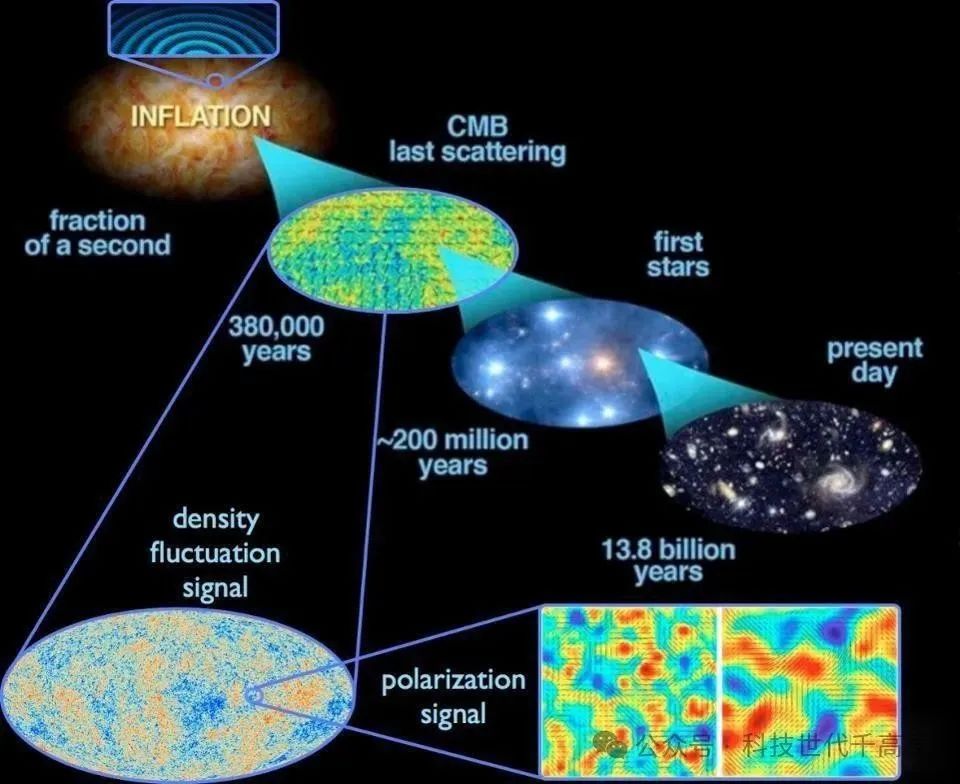
宇宙膨胀期间,空间固有的量子涨落遍布整个宇宙,引起了宇宙微波背景中密度涨落的产生,进而产生了当今宇宙中的恒星、星系和其他大尺度结构。这是我们对整个宇宙行为的最佳描绘,其中膨胀先于大爆炸并奠定了大爆炸的基础。不幸的是,我们只能获取我们宇宙视界内包含的信息,而这些都属于大约 138 亿年前膨胀结束的同一区域的同一部分。来源:E. Siegel;ESA/Planck 和 DOE/NASA/NSF CMB 研究跨部门工作组
在所有膨胀模型中,宇宙膨胀的最后时刻(即热大爆炸开始前的时刻)给宇宙留下了印记。这些最后时刻总是会产生两种类型的波动:
标量波动。这些表现为密度/温度缺陷,并导致宇宙的大尺度结构
张量波动。这些波动表现为膨胀遗留下来的引力波,并印刻在宇宙微波背景光的偏振上。具体来说,它们表现为我们所说的 B 模式:一种在光和引力波相互作用时发生的特殊偏振。
我们如何确定标量波动和张量波动?如前述文本所述,只有通货膨胀势的几个方面很重要。当你处于势的“山丘”高处时,就会发生通货膨胀,而当你滚入下面的“山谷”并留在那里时,通货膨胀就会结束。势的具体形状,包括其一阶和二阶导数,决定了这些波动的值,而势的“高点”与“低点”的高度决定了我们所说的 r:张量与标量波动的比率。这个可测量的量 r可以很大——最大可达 ~1。但它也可以非常小:可以 轻松降到 10 -20或更低。

膨胀遗留的引力波对宇宙微波背景 B 模式极化的贡献具有已知形状,但其振幅取决于特定的膨胀模型。这些来自膨胀引力波的 B 模式尚未被观测到,但探测到它们将极大地帮助我们确定发生的膨胀类型。BICEP2 团队在 2010 年代初发生了一次著名的错误探测。下一代 CMB 实验应该对低至 0.001 甚至更低的张量与标量比(即 r 比)敏感,但从未观测到过来自膨胀的 B 模式。
图片来源:普朗克科学团队
表面上看,考虑到可能存在如此大相径庭的预测,宇宙膨胀似乎无法预测任何情况。对于张量与标量之比 r的幅度,这是正确的,尽管每个模型对r都有自己独特的预测 。然而,我们可以提取一个非常清晰且普遍的预测:引力波(张量)波动的频谱应该是什么样的,以及它们的幅度在我们可以检查的任何尺度上是多少。当我们观察宇宙微波背景上留下的信号时,我们可以稳健地预测这些波动的相对大小从小角度尺度到大角度尺度。除了观察之外,唯一不受约束的是频谱的绝对“高度”,因此也是 r的幅度。
2000 年代中期,NASA/NSF/DOE 成立了一个跨部门工作组,着手规划新一代实验,以测量小角度尺度上宇宙微波背景光的偏振,这些实验专门用于限制 r 并验证或排除各种膨胀模型。许多天文台和实验都是为了实现这一目标而设计和建造的:BICEP、POLARBEAR、SPTpol 和 ACTPOL 等。目标是将 r限制 到约 ~0.001。如果膨胀产生的引力波发出足够大的信号,我们就会看到它们。如果没有,我们会设置有意义的限制并排除整个类别的膨胀模型。随着新的观测数据的出现,理论家开始制作具有大 r 值的模型,这些模型将落在测试区域内,因此与这些实验相关。
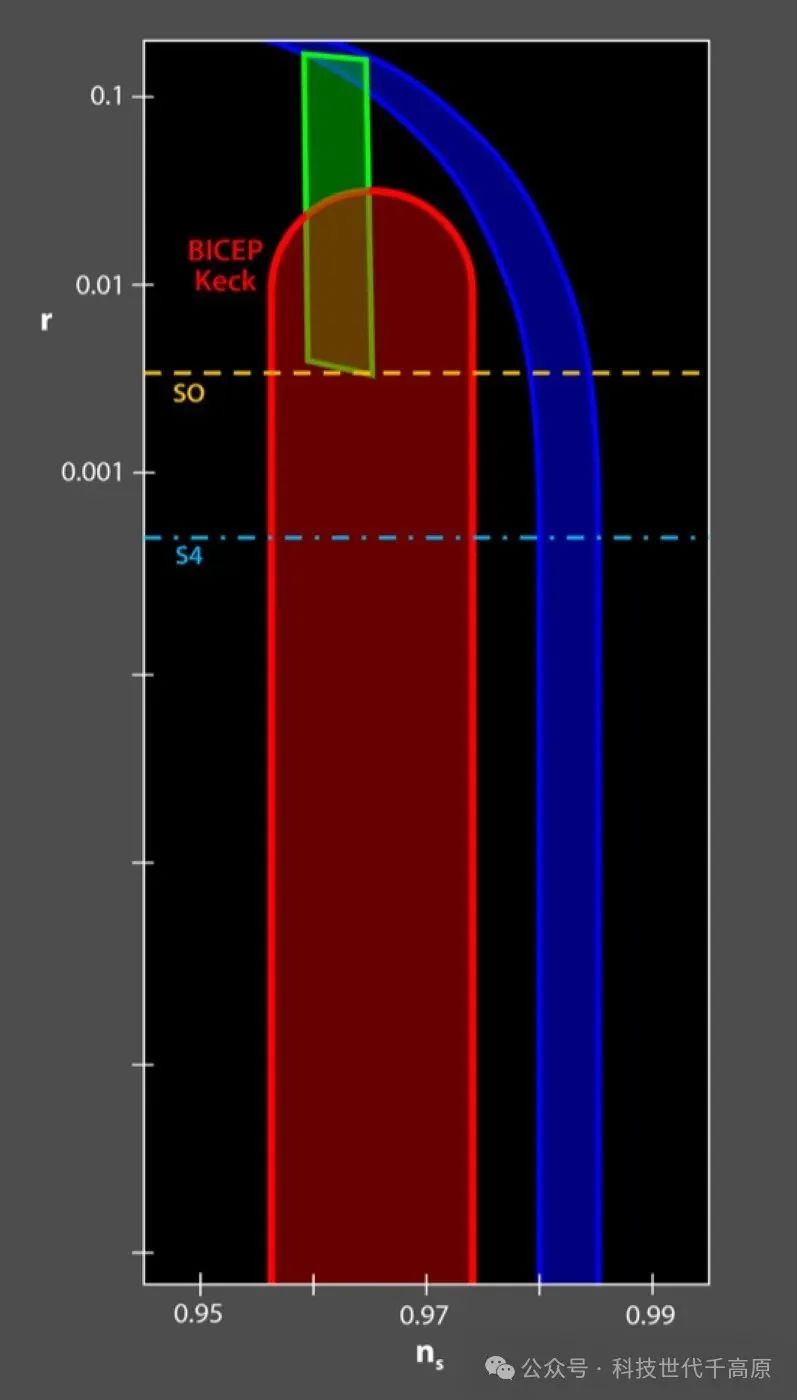

根据我们掌握的最敏感的约束条件,从最新的 BICEP/Keck 数据来看,红色阴影区域是通货膨胀模型所允许的全部区域。理论家们一直在研究很快就可以排除的区域(绿色、蓝色),但 r 的可行值可以小到我们构建模型所需的程度。在许多模型中,绿色曲线也可以进一步向下延伸。来源:APS/Alan Stonebreaker,由 E. Siegel 修改
从很多方面来看,目前最好的数据来自 BICEP 合作, 他们目前正在进行第三次实验。r 只有上限,现在限制为不大于 0.03 左右。然而,没有证据并不代表不存在。我们没有测量这个信号并不意味着它不存在,而是如果它存在,那么它就低于我们目前的观测能力。
尚未发现这些张量波动绝对 不 意味着宇宙膨胀理论是错误的。大量独立的观测测试充分证实了膨胀理论,只有当我们确实检测到这些张量模式时,数据才会证明膨胀理论是错误的,而这些张量模式并不遵循膨胀理论所预测的精确光谱。
然而,如果你听了与 BICEP 相关的科学家以及他们向世界发布的面向公众的交流,你永远不会知道这些。他们继续声称:
通胀仍存疑,
B 模式(表示张量波动)对于验证通货膨胀是必要的,
如果 没有大的幅度,通货膨胀就是伪造的,
我们可能正处于范式转变的边缘,
周期模型是通货膨胀的有力竞争对手,
并且通货膨胀只是将“单一大爆炸”移到了通货膨胀之前,而不是紧接着热大爆炸之前。

在这张宇宙时间轴/历史图中,BICEP2 合作将大爆炸置于膨胀之前,这是一个常见但无法接受的错误。尽管近 40 年来这一直不是该领域的主流思想,但它可以作为一个例子,说明当今人们由于粗心大意而错误理解了一个众所周知的细节。图片来源:NSF(NASA、JPL、凯克基金会、摩尔基金会、相关机构)——资助的 BICEP2 项目
坦率地说,所有这些断言都是不正确和不负责任的。最糟糕的是,我采访过的每一位提出这些主张的科学家都知道他们是错误的。然而,这些主张仍然由进行这些实验的科学家提出——包括通过流行疗法向公众提出。没有好的方式可以掩饰它:如果它不是自欺欺人,那就是彻头彻尾的学术欺诈。事实上,当一位科学家做出一个夸大其词和过早的断言,经过仔细检查后发现是完全错误的,我们天文学界的一些人称之为“BICEP2”,以他们 在 2014 年宣布的臭名昭著的错误发现命名。
最重要的是,这很可惜。这些实验以如此非凡的精度测量了宇宙微波背景的特性,为我们提供了有关宇宙本质以及在热大爆炸之前、建立和导致热大爆炸的膨胀时代的最佳信息。宇宙膨胀已被充分证实是我们宇宙的起源。它取代了非膨胀、包含奇点的大爆炸,成为我们所有人起源的宇宙学标准模型。尽管存在相反的替代方案,但它们都没有在宇宙膨胀无法实现的地方取得成功。同时,它们都未能重现膨胀的全部成功。
那些只重视荣誉和关注而不重视准确性的科学家无疑会继续做出毫无根据的断言,削弱我们对宇宙的真正了解。但不要被这种说法所愚弄。归根结底,我们通过向宇宙提出有关自身的问题并倾听其反应来了解宇宙中存在的东西。一旦我们放弃这种方法,我们就不得不承认一个令人不安的事实:我们根本不再从事科学研究了。
伊森正在度暑假。请欣赏这篇来自《Starts With A Bang》档案的文章!
If the Big Bang wasn’t the first thing ever, what caused it?
Many contrarians dispute that cosmic inflation occurred. The evidence says otherwise.
The expanding Universe, full of galaxies and the complex structure we observe today, arose from a smaller, hotter, denser, more uniform state. Although the extent of the observable Universe, today, takes us out some 46 billion light-years in all directions, in the distant cosmic past, everything in space was much more compact, closer together, and occupied a much smaller volume, begging the question: what drives the expansion of the Universe, both initially, at the start of the hot Big Bang, and today, at late cosmic times, where the expansion is accelerating?
Credit: C.-A. Faucher-Giguere, A. Lidz, and L. Hernquist, Science, 2008
KEY TAKEAWAYS
Studying the Big Bang tells us how our universe evolved to become this way, but it doesn’t immediately reveal why the Big Bang occurred or what might have preceded it.
Theoretically and observationally, the evidence for cosmic inflation preceding and setting up the Big Bang is incredibly strong and comprehensive.
There are still some new, sensitive things to measure, but the lack of low-hanging fruit doesn’t mean the tree is dead.
Ethan Siegel
Travel the universe with Dr. Ethan Siegel as he answers the biggest questions of all
Fields marked with an * are required
For as long as humans have been around, our innate curiosity has compelled us to ask questions about the universe. Why are things the way they are? How did they get to be this way? Were these outcomes inevitable or could things have turned out differently if we rewound the clock and began things all over again? From subatomic interactions to the grand scale of the cosmos, it’s only natural to wonder about it all. For innumerable generations, these were questions that philosophers, theologians, and mythmakers attempted to answer. While their ideas may have been interesting, they were anything but definitive.
Michio Kaku: Quantum computing is the next revolution
Modern science offers a superior way of approaching these puzzles. No longer do we consider the Big Bang, once thought to be the ultimate origin of our Universe, to have occurred at a single moment or event in space and time. We can now ask questions such as “What existed before the Big Bang?” as well as “Why did the Big Bang happen?” When it comes to even the biggest questions of all, science provides us with the best answers we can muster, given what we know and what remains unknown, at any point in time. Here and now, these are the best robust conclusions we can reach.
上传失败,网络异常。
重试
A visual history of the expanding Universe includes the hot, dense state known as the Big Bang and the growth and formation of structure subsequently. The full suite of data, including the observations of the light elements and the cosmic microwave background, leaves only the Big Bang as a valid explanation for all we see. As the Universe expands, it also cools, enabling ions, neutral atoms, and eventually molecules, gas clouds, stars, and finally galaxies to form.
Credit: NASA/CXC/M. Weiss
When we look out at the galaxies in the universe today, we find that — on average — the farther away it is, the greater the amount its light is shifted toward longer and redder wavelengths. The longer light spends traveling through the universe before it reaches our eyes, the greater the amount that the expansion of the universe stretches its wavelength; this was how we discovered that the universe is expanding. Because stretched, longer-wavelength light is colder than shorter-wavelength light, the universe cools as it expands. If we extrapolate backward in time instead of forward, we’d expect the early universe to exist in a hotter, denser, more uniform state.
Originally, we took the extrapolation as far back as we could imagine — to infinite temperatures and densities, and an infinitesimally small volume: a singularity. Evolving forward from that initial state, we successfully predicted and later observed:
the leftover radiation from the Big Bang, observable as the cosmic microwave background
the abundance of the light elements before any stars were formed
the gravitational growth of large-scale structure in the universe
However, we also observed things we couldn’t explain if the universe began from a singular state, including why there were no leftover relics from the highest-energy epochs, why the universe had the same properties in opposite directions that could never have exchanged information with one another, and why there was absolutely no spatial curvature, leaving the universe indistinguishable from flat.
上传失败,网络异常。
重试
The magnitudes of the hot and cold spots, as well as their scales, indicate the curvature of the universe. To the best of our capabilities, we measure it to be perfectly flat. Baryon acoustic oscillations and the CMB, together, provide the best methods of constraining this, down to a combined precision of 0.4%. To the best we can measure, the universe is indistinguishable from spatially flat.
Credit: Smoot Cosmology Group/LBL
Whenever we reach this scenario — observing properties that our leading theories cannot explain or predict — we are left with two options:
You can pawn off the properties as “initial conditions.” Why is the universe flat? It was born that way. Why is it the same temperature everywhere? Born that way. Why aren’t there high-energy relics? They must not exist. And so on. This option offers no explanation.
You can imagine some sort of dynamics: a mechanism that precedes the state we’ve observed and sets it up, so that it started off with the conditions necessary to create the properties we observe today.
Although it’s a bit controversial to say, the first option is only acceptable when you are certain that the conditions you could have started off with are sufficiently random. For example, solar systems form from instabilities in protoplanetary disks around newly forming stars; that’s random, and so there’s no explanation for why our solar system possesses its particular set of planets. But for the entire universe, choosing that option is tantamount to giving up on dynamics, asserting that there’s no need to even search for a mechanism that could have preceded and set up the hot Big Bang.
上传失败,网络异常。
重试
The stars and galaxies we see today didn’t always exist, and the farther back we go, the closer to an apparent singularity the Universe gets, as we go to hotter, denser, and more uniform states. However, there is a limit to that extrapolation, as going all the way back to a singularity creates puzzles we cannot answer.
Credit: NASA, ESA, and A. Feild (STScI)
Fortunately, however, not everyone fell into that solipsistic logical fallacy. If you want to go beyond your current understanding of how things work, all it takes is a new, superior idea. How do you know whether an idea is good enough to supersede our old theory and revolutionize our view of the universe? Believe it or not, there are just three criteria you have to meet:
It has to reproduce every success that the old theory achieved. Every single one, with no exception.
It has to succeed where the old theory didn’t, by successfully explaining the phenomena the old theory couldn’t.
It needs, perhaps most importantly, to make novel predictions that differ from the old theory’s predictions. These novel predictions must then be tested to determine the new idea’s failure or success.
That was precisely what, a little more than 40 years ago, the concept of cosmic inflation (sometimes known as cosmological inflation) set out to do. It hypothesized that before the universe was filled with matter and radiation, it was dominated by energy inherent to the fabric of space itself. That energy caused the universe to expand exponentially and relentlessly. The expansion would stretch space so that it was seemingly flat, causing all directions to have the same temperature because everything was causally connected in the past. Ultimately, this process would place an upper limit on the maximum temperature achieved in the early universe, preventing the formation of high-energy relics.
In the top panel, our modern Universe has the same properties (including temperature) everywhere because they originated from a region possessing the same properties. In the middle panel, the space that could have had any arbitrary curvature is inflated to the point where we cannot observe any curvature today, solving the flatness problem. And in the bottom panel, pre-existing high-energy relics are inflated away, providing a solution to the high-energy relic problem. This is how inflation solves the three great puzzles that the Big Bang cannot account for on its own.
Credit: E. Siegel/Beyond the Galaxy
The initial model of cosmic inflation succeeded where the Big Bang without inflation failed, but it struggled to meet the first criterion, in that it failed to produce a universe that had uniform properties in all directions. However, with the work of the community, class models were swiftly discovered that reproduced the Big Bang’s successes, and that led to a rich era of theoretical exploration. We would model cosmic inflation as a field, and then the laws of physics would enable us to extract the properties imprinted on the universe from any particular model we chose. These details were worked out largely during the 1980s and the 1990s, and are found in a variety of textbooks in the field, including:
Kolb and Turner’s The Early Universe,
John Peacock’s Cosmological Physics,
Liddle and Lyth’s Cosmological Inflation and Large-Scale Structure,
and Scott Dodelson’s Modern Cosmology.
Dodelson’s book became the field’s standard on how cosmic inflation’s imprints are left on the universe, particularly in the cosmic microwave background. If you studied cosmology at the graduate level within the past 30 years, these were many of the seminal primary sources that taught you how to extract some key predictions from inflation that would differ from a universe where inflation did not occur.
The large, medium, and small-scale fluctuations from the inflationary period of the early universe determine the hot and cold (underdense and overdense) spots in the Big Bang’s leftover glow. These fluctuations, which get stretched across the Universe in inflation, should be of a slightly different magnitude on small scales versus large ones: a prediction that was observationally borne out at approximately the ~3% level.
Credit: NASA/WMAP Science Team
In particular, there are six major predictions of cosmic inflation that were definitively extracted before they were ever put to the test. Inflation predicts:
a spectrum of imperfections — density and temperature fluctuations — that are almost, but not perfectly, scale-invariant
a universe that’s coarsely indistinguishable from flat, but that has curvature to it at the ~0.001% level
density imperfections that are 100% adiabatic and 0% isocurvature in nature
fluctuations on super-horizon scales, which are larger than a signal moving at the speed of light in an expanding universe could create
a finite maximum temperature to the universe during the hot Big Bang, which should be significantly smaller than the Planck scale
a spectrum of gravitational wave fluctuations — tensor fluctuations — should be created as well, with a particular pattern to it.
All six of these predictions were in place long before the first data from the WMAP or Planck satellites came back, allowing us to test cosmic inflation versus a non-inflationary scenario. We’ve since observed strong evidence favoring cosmic inflation for points 1, 3, 4, and 5, and have yet to reach sensitivities that reveal a decisive signal for points 2 and 6. However, going 4-for-4 where we’ve been able to test it has been more than sufficient to validate inflation, rendering it the new consensus explanation for the origin of our universe. Inflation came before and set up the hot Big Bang, with extrapolation back to a singularity having now become an unfounded assumption.
The modern cosmic picture of our universe’s history begins not with a singularity that we identify with the Big Bang, but rather with a period of cosmic inflation that stretches the universe to enormous scales, with uniform properties and spatial flatness. The end of inflation signifies the onset of the hot Big Bang.
Credit: NASA/WMAP science team
Still, it’s possible to go a little deeper than this aspect of the story would lead us to believe. As is almost always the case in science, learning something new about the universe only raises additional questions. What exactly is the nature of cosmic inflation? How long was its duration? What caused the universe to inflate at all? If cosmic inflation is caused by a quantum field — a justifiable assumption to make — then what are the properties of that field? Just as before, if we want to answer these questions, we have to find ways of testing the nature of inflation and then subject the universe to those tests.
The way we explore this is by building inflationary models — leveraging effective field theories — and extracting the key predictions from various models of inflation. Generically, you have a potential, you get inflation when the ball is “high up on a hill” on the potential, and inflation ends when the ball rolls down from a high point into a “valley” of the potential: a minimum. By calculating various properties of cosmic inflation from these potentials, you can extract predictions for the signals you expect to exist in your universe.
Then, we can go out and measure the universe, such as by measuring some precise and intricate properties of the light that composes the cosmic microwave background, and compare them to the various models we’ve concocted. The ones that remain consistent with the data are still viable, while the ones in conflict with the data can be ruled out. This interplay of theory and observation are how all astronomical sciences, including cosmology and the science of the early universe, advance.
The quantum fluctuations inherent to space, stretched across the Universe during cosmic inflation, gave rise to the density fluctuations imprinted in the cosmic microwave background, which in turn gave rise to the stars, galaxies, and other large-scale structures in the Universe today. This is the best picture we have of how the entire Universe behaves, where inflation precedes and sets up the Big Bang. Unfortunately, we can only access the information contained inside our cosmic horizon, which is all part of the same fraction of one region where inflation ended some 13.8 billion years ago.
Credit: E. Siegel; ESA/Planck and the DOE/NASA/NSF Interagency Task Force on CMB research
In all inflationary models, it’s the final moments of cosmic inflation — the ones that occur just prior to the onset of the hot Big Bang — that leave their imprints on the universe. These final moments always produce two types of fluctuations:
scalar fluctuations. These appear as density/temperature imperfections and lead to the large-scale structure of the universe
tensor fluctuations. These show up as gravitational waves left over from inflation, and imprint themselves on the polarization of the light from the cosmic microwave background. Specifically, they appear as what we call B-modes: a special type of polarization that happens when light and gravitational waves interact.
How do we determine what the scalar fluctuations and the tensor fluctuations are? As detailed in the aforementioned texts, there are only a few aspects of the inflationary potential that matter. Inflation occurs when you’re high up on the “hill” of a potential inflation ends when you roll into the “valley” below and stay there. The specific shape of the potential, including its first and second derivatives, determine the values of these fluctuations, while the height of the “high point” versus the “low point” of the potential determines what we call r: the ratios of tensor-to-scalar fluctuations. This measurable quantity, r, can be large — up to ~1. But it can also be very small: down to 10-20 or lower without any difficulties.
The contribution of gravitational waves left over from inflation to the B-mode polarization of the Cosmic Microwave background has a known shape, but its amplitude is dependent on the specific model of inflation. These B-modes from gravitational waves from inflation have not yet been observed, but detecting them would help us tremendously in pinning down precisely what type of inflation occurred. A false detection, from the BICEP2 team, famously occurred in the early 2010s. The upcoming generation of CMB experiments should be sensitive to tensor-to-scalar ratios (i.e., r-ratios) as low as 0.001, or possibly even less, but no B-modes from inflation have ever been robustly observed.
Credit: Planck Science Team
On the surface, it might seem that cosmic inflation doesn’t predict anything on this front, considering that such widely disparate predictions are possible. For the amplitude of the tensor-to-scalar ratio, r, that’s correct, though each model will have its own unique prediction for r. However, there is a very clean and universal prediction that we can extract: what the spectrum of gravitational wave (tensor) fluctuations should look like, and what their magnitude is on any scale we can examine. When we look at the signals that get imprinted on the cosmic microwave background, we can robustly predict what the relative size of these fluctuations are from small angular scales up to large ones. The only thing that’s unconstrained, except by observation, is the absolute “height” of the spectrum, and hence, the magnitude of r.
In the mid-2000s, there was an NASA/NSF/DOE interagency task force that set about planning a new generation of experiments to measure the polarization of the light from the cosmic microwave background on small angular scales, specifically designed to constrain r and either validate or rule out various models of inflation. Numerous observatories and experiments were designed and built to achieve that goal: BICEP, POLARBEAR, SPTpol, and ACTPOL, to name a few. The goal was to constrain r down to about ~0.001. If the gravitational waves from inflation made a large enough signal, we’d see them. If not, we’d place meaningful constraints and rule out whole classes of inflationary models. With new observational data coming, theorists set about making models with large r values, which would fall in the testing area and hence would be relevant for these experiments.
According to the most sensitive constraints we have, from the latest BICEP/Keck data, the red shaded area is all that’s permitted as far as inflationary models go. Theorists have been mucking around in regions that can soon be excluded (green, blue), but viable values of r can be as small as we care to build our models. The green curve, as well, can be extended farther down in many models.
Credit: APS/Alan Stonebreaker, modified by E. Siegel
In many ways, the best data currently comes from the BICEP collaboration, currently on the third iteration of their experiment. There are only upper limits on r, now constrained to be no greater than about 0.03 or so. However, absence of evidence is not evidence of absence. The fact that we haven’t measured this signal doesn’t mean it isn’t there, but rather that if it is there, then it’s below our current observational capabilities.
What failing to find these tensor fluctuations (yet) definitely, definitely does not mean is that cosmic inflation is wrong. Inflation is well-validated by numerous independent observational tests, and would only be falsified by the data if we did detect these tensor modes, and they didn’t follow the precise spectrum predicted by inflation.
And yet, you’d never know any of this by listening to the scientists associated with BICEP and the public-facing communication they’ve put out into the world. They continue to assert that:
inflation remains in doubt,
B-modes (indicating tensor fluctuations) are necessary to validate inflation,
if there aren’t large magnitude ones, inflation is falsified,
we are likely on the cusp of a paradigm shift,
cyclic models are a viable competitor to inflation,
and that inflation simply moved the “singular Big Bang” to before inflation, rather than immediately preceding the hot Big Bang.
In this timeline/history of the Universe graphic, the BICEP2 collaboration places the Big Bang before inflation, a common but unacceptable error. Even though this hasn’t been the leading thought in the field in nearly 40 years, it serves as an example of people, today, getting a well-known detail wrong through simple lack-of-care.
Credit: NSF (NASA, JPL, Keck Foundation, Moore Foundation, Related) – Funded BICEP2 Program
All of these assertions, to be blunt, are both incorrect and irresponsible. Worst of all, every single one of the scientists I’ve spoken to who has made these claims knows they’re incorrect. However, the claims are still advanced — including to the general public through popular treatments — by the very scientists who are running these experiments. There’s no kind way to couch it: if it isn’t self-deception, it’s utter intellectual dishonesty. In fact, when a scientist makes an overblown and premature claim that turns out, on closer inspection, to be completely wrong, some of us in the astronomical community call that a “BICEP2,” named after the infamous false discovery they announced back in 2014.
Most of all, it’s a pity. These experiments that measure the properties of the cosmic microwave background to such extraordinary precisions are giving us the best information we’ve ever had about the nature of the universe, and of the inflationary epoch that preceded and set up — and caused — the hot Big Bang. Cosmic inflation is well validated as the origin of our universe. It has replaced the noninflationary, singularity-containing Big Bang as our cosmological standard model for where we all came from. Although there are contrarian alternatives out there, none of them have ever succeeded where cosmic inflation does not. Meanwhile, they all fail to reproduce the full suite of inflation’s successes.
Scientists who value glory and attention over accuracy will no doubt continue to make baseless assertions undercutting what’s actually known about the universe. But don’t be fooled by such claims. At the end of the day, we learn what exists in the universe by asking it questions about itself and listening to its response. As soon as we abandon that approach, we have to admit the uncomfortable truth: we simply aren’t doing science anymore.
Ethan is out on summer vacation. Please enjoy this article from the Starts With A Bang archives!
未来智能实验室的主要工作包括:建立AI智能系统智商评测体系,开展世界人工智能智商评测;开展互联网(城市)大脑研究计划,构建互联网(城市)大脑技术和企业图谱,为提升企业,行业与城市的智能水平服务。每日推荐范围未来科技发展趋势的学习型文章。目前线上平台已收藏上千篇精华前沿科技文章和报告。
如果您对实验室的研究感兴趣,欢迎加入未来智能实验室线上平台。扫描以下二维码或点击本文左下角“阅读原文”

























 被折叠的 条评论
为什么被折叠?
被折叠的 条评论
为什么被折叠?








